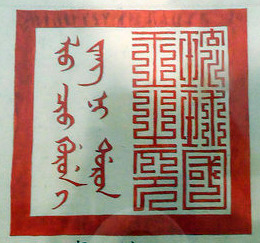Difference between revisions of "Ryukyuan royal seal"
| (One intermediate revision by the same user not shown) | |||
| Line 2: | Line 2: | ||
*''Japanese/Chinese'': 琉球國王之印 ''(Ryûkyû kokuô no in / Liúqiú guówáng zhī yìn)'' | *''Japanese/Chinese'': 琉球國王之印 ''(Ryûkyû kokuô no in / Liúqiú guówáng zhī yìn)'' | ||
| − | The royal seal of the [[Kingdom of Ryukyu|Kingdom of Ryûkyû]] was bestowed upon the kingdom by the Chinese court as part of the [[Ming Dynasty|Ming]] and [[Qing Dynasty|Qing Dynasties']] [[Chinese investiture envoys|investiture]] of the Ryukyuan king. This was a standard element of the [[tribute|tributary]]-investiture system; seals like it were granted to all of China's major tributaries.<ref>David C. Kang, “Hierarchy in Asian International Relations: 1300-1900.” ''Asian Security'' 1, no. 1 (2005): 62.; Anthony Reid, "Introduction," in Reid & Zheng Yangwen (eds.), ''Negotiating Asymmetry: China's Place in Asia'' (NUS Press, 2009), 13-14. </ref> It was used to authorize official documents, both within the kingdom, and in communications with foreign courts. | + | The royal seal of the [[Kingdom of Ryukyu|Kingdom of Ryûkyû]] was bestowed upon the kingdom by the Chinese court as part of the [[Ming Dynasty|Ming]] and [[Qing Dynasty|Qing Dynasties']] [[Chinese investiture envoys|investiture]] of the Ryukyuan king. This was a standard element of the [[tribute|tributary]]-[[investiture]] system; seals like it were granted to all of China's major tributaries.<ref>David C. Kang, “Hierarchy in Asian International Relations: 1300-1900.” ''Asian Security'' 1, no. 1 (2005): 62.; Anthony Reid, "Introduction," in Reid & Zheng Yangwen (eds.), ''Negotiating Asymmetry: China's Place in Asia'' (NUS Press, 2009), 13-14. </ref> It was used to authorize official documents, both within the kingdom, and in communications with foreign courts. |
The kingdom was first granted an official seal by the [[Hongwu Emperor]] of the Ming Dynasty in the 1370s, following the kingdom of [[Chuzan|Chûzan]] sending a formal tribute mission for the first time in [[1372]]. | The kingdom was first granted an official seal by the [[Hongwu Emperor]] of the Ming Dynasty in the 1370s, following the kingdom of [[Chuzan|Chûzan]] sending a formal tribute mission for the first time in [[1372]]. | ||
| − | The seal was of a style known as "camel | + | The seal was of a style known as "camel back," as it had a grip shaped like a camel's hump. Like the "camel back" seals issued to Vietnam, Siam, Java, and certain other kingdoms, it was made of gilded silver. This was in contrast to the seals bestowed upon the kings of [[Joseon]] dynasty Korea and the [[Muromachi shogunate|Muromachi shoguns]] (as "king of Japan"), which were solid gold, with grips in the shape of turtles.<ref>Akamine Mamoru, Lina Terrell (trans.), Robert Huey (ed.), ''The Ryukyu Kingdom: Cornerstone of East Asia'', University of Hawaii Press (2017), 128.</ref> |
Crown Prince [[Sho Tei|Shô Tei]] journeyed to China in [[1654]] and returned the royal seal bestowed upon the kingdom by the Ming, receiving an official seal from the Qing in its place.<ref>Angela Schottenhammer, “Empire and Periphery? The Qing Empire’s Relations with Japan and the Ryūkyūs (1644–c. 1800), a Comparison.” ''The Medieval History Journal'' 16, no. 1 (April 1, 2013): 176-179.</ref> | Crown Prince [[Sho Tei|Shô Tei]] journeyed to China in [[1654]] and returned the royal seal bestowed upon the kingdom by the Ming, receiving an official seal from the Qing in its place.<ref>Angela Schottenhammer, “Empire and Periphery? The Qing Empire’s Relations with Japan and the Ryūkyūs (1644–c. 1800), a Comparison.” ''The Medieval History Journal'' 16, no. 1 (April 1, 2013): 176-179.</ref> | ||
Latest revision as of 11:29, 31 March 2018

- Japanese/Chinese: 琉球國王之印 (Ryûkyû kokuô no in / Liúqiú guówáng zhī yìn)
The royal seal of the Kingdom of Ryûkyû was bestowed upon the kingdom by the Chinese court as part of the Ming and Qing Dynasties' investiture of the Ryukyuan king. This was a standard element of the tributary-investiture system; seals like it were granted to all of China's major tributaries.[1] It was used to authorize official documents, both within the kingdom, and in communications with foreign courts.
The kingdom was first granted an official seal by the Hongwu Emperor of the Ming Dynasty in the 1370s, following the kingdom of Chûzan sending a formal tribute mission for the first time in 1372.
The seal was of a style known as "camel back," as it had a grip shaped like a camel's hump. Like the "camel back" seals issued to Vietnam, Siam, Java, and certain other kingdoms, it was made of gilded silver. This was in contrast to the seals bestowed upon the kings of Joseon dynasty Korea and the Muromachi shoguns (as "king of Japan"), which were solid gold, with grips in the shape of turtles.[2]
Crown Prince Shô Tei journeyed to China in 1654 and returned the royal seal bestowed upon the kingdom by the Ming, receiving an official seal from the Qing in its place.[3]
References
- ↑ David C. Kang, “Hierarchy in Asian International Relations: 1300-1900.” Asian Security 1, no. 1 (2005): 62.; Anthony Reid, "Introduction," in Reid & Zheng Yangwen (eds.), Negotiating Asymmetry: China's Place in Asia (NUS Press, 2009), 13-14.
- ↑ Akamine Mamoru, Lina Terrell (trans.), Robert Huey (ed.), The Ryukyu Kingdom: Cornerstone of East Asia, University of Hawaii Press (2017), 128.
- ↑ Angela Schottenhammer, “Empire and Periphery? The Qing Empire’s Relations with Japan and the Ryūkyūs (1644–c. 1800), a Comparison.” The Medieval History Journal 16, no. 1 (April 1, 2013): 176-179.